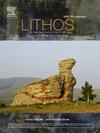Paleoarchean continental crust formation by reworking of juvenile crust: Evidence from SE part of Singhbhum Craton, eastern India
IF 2.9
2区 地球科学
Q2 GEOCHEMISTRY & GEOPHYSICS
引用次数: 0
Abstract
Formation, evolution, and preservation of early continental crust have been a subject of intense debate. This is testified by the fragmentary nature of our understanding on the composition of early earth mantle, temporal evolution of the composition and thickness of continental crust, and the linkage between granitoid diversification, spatial crustal heterogeneity and geodynamic processes. In pursuant to these problems, we investigated the poorly-studied Paleoarchean granitoids exposed in the south-eastern part of the Singhbhum Craton. At ∼3.50 Ga, shallow (low-pressure) crustal melting produced sodic granitoids (trondhjemite) in this area. This was followed by emplacement of both low- and high-pressure sodic granitoids (tonalite and trondhjemite) over ∼3.33–3.29 Ga and K-rich granites at ∼3.28 Ga; we link this magmatism with crustal thickening allowing intracrustal melting at variable depths. All the granitoids display suprachondritic to near-chondritic zircon epsilon values. This fact reflects continued addition of juvenile crust from depleted mantle (with minor input from older crust) and its rapid differentiation into felsic composition. The process implies a unique crust formation mechanism in Paleoarchean. Our synthesis suggests that the Paleoarchean granitoid crust within Singhbhum Craton can be divided into several blocks surrounded by slivers of greenstone belts. Crust generation histories of these blocks are often diachronous and follow distinct evolution paths (in terms of spatial and temporal pattern of granitoid diversification) which can be linked to the thickness variation and compositional heterogeneity of the cratonic crust.
求助全文
约1分钟内获得全文
求助全文
来源期刊

Lithos
地学-地球化学与地球物理
CiteScore
6.80
自引率
11.40%
发文量
286
审稿时长
3.5 months
期刊介绍:
Lithos publishes original research papers on the petrology, geochemistry and petrogenesis of igneous and metamorphic rocks. Papers on mineralogy/mineral physics related to petrology and petrogenetic problems are also welcomed.
 求助内容:
求助内容: 应助结果提醒方式:
应助结果提醒方式:


